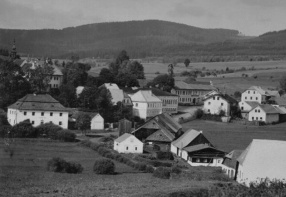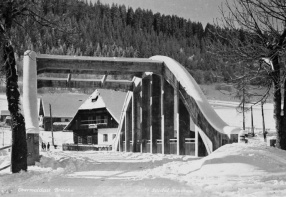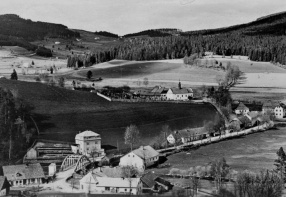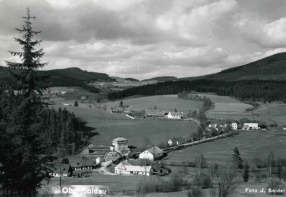HISTORY OF THE VILLAGE
The village was founded in vicinity of a ford across the Teplá Vltava river on one of the branches of the medieval Golden Path connecting German Passau and Vimperk. In times around 200 B.C. already, the Celts started to mine gold in the Šumava. There are many marks of gold panning still perceivable in the surroundings of Horní Vltavice. Panning sites can be found on the Kaplický stream beneath the road from Zátoň and to the north-west of Horní Vltavice there are small hillocks called "sejpy" in the alluvia of the Teplá Vltava. Although the first historically documented record of Horní Vltavice dates back to 1359, it is clear that the place where the caravans going down the Vimperk branch of the Golden path forded the Vltava river was settled much earlier already. When the trade traffic on the Golden Path attenuated, the locals started to make their living in the field of glass-making as was the case in many other villages of the Šumava. In the 16th and 17th centuries there were several glass-works in the village itself and its vicinity. The existence of the most interesting of the glass-works manufacturing mirror glass was documented in 1618.
After arrival of the Schwarzenberg family to the area in 1719, local dwellers started to take advantage of seemingly infinite abundance of the forests to earn their living. The origin of woodworking villages as was Slatina, Březová Lada, Račí or Polka lying in the cadastre of Horní Vltavice falls into this period. In 1907, the village had 2 793 inhabitants, of which 503 in Horní Vltavice itself, 1 307 jointly in Zátoň, Kaplice and Lenora (falling into the administrative area of Horní Vltavice till 1949), 161 in Račí, 140 in Kubova Huť (falling into the administrative area of Horní Vltavice till 1990), 276 in Žlíbky, 180 in Polka, 89 in Slatina and 137 in Březová Lada. The war conflicts of the 20th century significantly affected lives of the locals. The victims of the World War I are commemorated by a memorial to sixty-three fallen from the villages of Horní Vltavice, Račí, Kubova Huť, Slatina, Polka, Březová Lada, Zátoň, Houžná and Vlčí Jámy placed at the cemetery of Horní Vltavice. A memorial to twenty-two victims of Lenora was raised right in this village.
As a consequence of the Munich Agreement the Czechoslovak Republic was split and the territory of Horní Vltavice passed to Germany. Horní Vltavice was seized by the German Army on 2nd October 1938. The seizure was nevertheless regarded as national liberation due to the ethnic composition of its population. The majority of the male inhabitants was drafted into the Wermacht Units and left for the front-line. This loss was substituted by the prisoners of war (the Soviets, the French, the Belgians, The Dutch, the Ukrainians, the Polish and others) who were staying in several labour camps at the territory of the village. The prisoners of war were working mainly in the forests on wood cutting, charcoal production and resin collection. After considerably severe fights in Strážný on the eve of the 5th May 1945, the village of Horní Vlatvice was occupied by the 5th Infantry Division (Red Diamond) of the 3rd American Army of General George S. Patton. 150 men of the village never came back from the battlefields of the World War II.
Only a few days before the end of the war a death march passed through the village, which brought unbelievable sufferings to hundreds of Jewish women and girls. Thirteen of them ended up their distressful journey in Polka, where they were buried in shallow graves and their corpses were later moved to Volary. At the edge of Horní Vlravice, an unknown twenty-six year old woman was taken out of the transport and shot. She was later buried in the top right corner of the cemetery of Horní Vltavice.
After the World War II in 1945, the original German inhabitants of the village were displaced. Their displacement and resettlement of the Czech borderline zone brought deep social and economic changes in the post-war history of the village. The Mountainous Pasturing Cooperative was established in Horní Vltavice and in 1949 the Domain Farm was founded here, which stayed in operation until 1994. Thanks to its location right in centre of the Šumava, Horní Vltavice is today a natural tourist centre and destination. It has approximately 400 inhabitants who work mostly in the fields of wood processing, agriculture and services.




